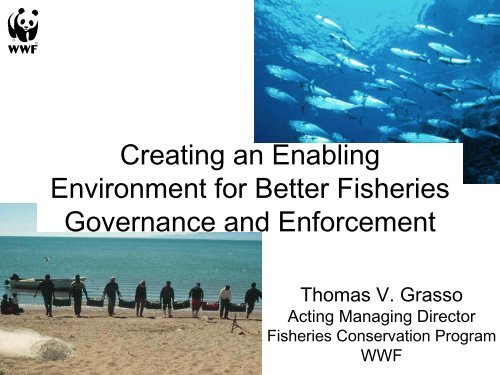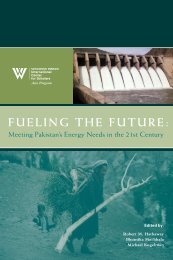Tom Grasso
Tom Grasso
Tom Grasso
You also want an ePaper? Increase the reach of your titles
YUMPU automatically turns print PDFs into web optimized ePapers that Google loves.
Creating an Enabling<br />
Environment for Better Fisheries<br />
Governance and Enforcement<br />
Thomas V. <strong>Grasso</strong><br />
Acting Managing Director<br />
Fisheries Conservation Program<br />
WWF
.<br />
The Global Fisheries Crisis: impacts<br />
on marine biodiversity<br />
– 75% of the world’s<br />
fisheries are fully<br />
exploited or overfished<br />
– Annual bycatch of over<br />
300,000 cetaceans<br />
250,000 sea turtles<br />
300,000 seabirds<br />
– 1% of the global<br />
fisheries are<br />
recovering (FAO)
Global Fisheries Benefits<br />
• World fisheries production in<br />
1999 generated $125 billionUS<br />
• Primary protein source for 950<br />
million people<br />
• Small-scale fisheries<br />
– 94% of the world’s fisheries<br />
– 50% of global fish supply for<br />
human consumption<br />
– 200 million people directly<br />
and indirectly employed
The Role of Developing Countries<br />
in the Global Seafood Market<br />
• Provide 57% of the global fish production<br />
• Earn $20.4 billionUS in net exports – more<br />
than rice, coffee, sugar and tea combined<br />
• Contributed 68% of global non-food fishery<br />
exports in 2004<br />
• Increased their share in food fishery<br />
exports from 43% in 1992 to 51% in 2004
Fishing pressure, Biodiversity<br />
richness and National incomes<br />
GNI data from the World Bank, Fish Catch Data from the Sea Around Us Project
Saving Fish and Fishers*<br />
Fisheries are directly linked with poverty and hunger<br />
(MDG 1), gender equity and women’s empowerment<br />
(MDG 3) and environmental sustainability (MDG 7).<br />
The WSSD 2004 called to combat overfishing and to<br />
build partnerships between donor agencies and<br />
stakeholders to achieve targets.
Protein Index<br />
251 - 800<br />
86 - 250<br />
25 - 85<br />
7 - 24<br />
0 - 6<br />
Fisheries in Africa:<br />
Food Security and Exports<br />
Export Index<br />
5 - 14<br />
2 - 4<br />
1<br />
1 - 0<br />
Data from Sea Around Us Project, World Resources Institute, and Food and Agriculture Organization<br />
0<br />
Biodiversity Priority Areas
Protein<br />
16 - 26<br />
10 - 15<br />
6 - 9<br />
3 - 5<br />
0 - 2<br />
Fisheries in SE Asia:<br />
Food Security and Exports<br />
Export Index<br />
5 - 14<br />
2 - 4<br />
Data from Sea Around Us Project, World Resources Institute, and Food and Agriculture Organization<br />
1<br />
1 - 0<br />
0<br />
Biodiversity Priority Areas
Fisheries Catch in SE Asia<br />
1950<br />
1975<br />
2001
Fisheries in Indonesia<br />
• 67% of coral reefs in “poor to fair” condition<br />
• $59.8 billion US to national economy<br />
• Livelihood for 2 million people<br />
• Provides 53% of consumed animal protein<br />
• Foreign fleets take about 35% of total domestic<br />
catch from EEZ<br />
• Tuna exports to Japan (27%), Indonesia (18%),<br />
US and Korea (10% each)
Strategic Partnership for a<br />
Sustainable Fisheries Investment<br />
Fund in Africa
Rebuilding fishing communities in<br />
Aceh: Improving livelihoods and<br />
Tsunami impacts:<br />
• Lost nearly 60% of<br />
industries productive<br />
capacity<br />
restoring fish stocks<br />
• 10% of Aceh’s fishermen<br />
lost their lives<br />
• Estimated 10-year<br />
recovery period
Global Overfishing Cycle<br />
Adapted from Jorge, M. pers. com., 2007
Sustainable Fisheries Cycle<br />
Adapted from Jorge, M. pers. com., 2007

















